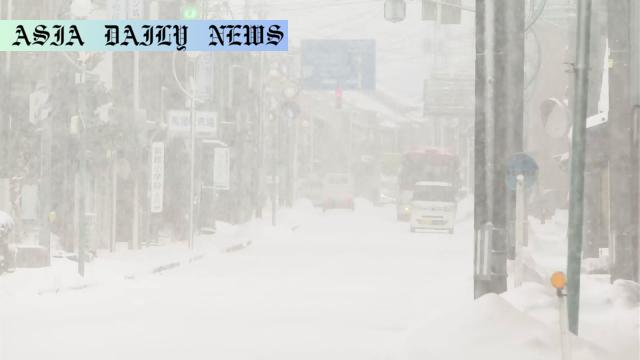Snowfall warning issued for Hokuriku and Chugoku regions as severe weather persists.
Snowfall continues to affect Japan’s Sea of Japan coast.
Accumulated snow exceeds average levels in many areas.
Residents warned about traffic disruption and avalanches.
Heavy snow expected in Hokuriku, Chugoku, and other regions.

Introduction: Extreme Snowfall in Japan
A strong cold air mass combined with a winter pressure pattern has caused persistent snowfall across the Sea of Japan coast, significantly impacting regions between Hokkaido and Chugoku. The Japan Meteorological Agency (JMA) has issued warnings for severe weather that is expected to continue until Monday, posing various challenges for residents, travelers, and infrastructure in affected areas.
Record-Breaking Snowfall Accumulation
The current snow levels in Japan have exceeded averages for many locations. As of Sunday morning, Sukayu in Aomori Prefecture recorded a staggering 5.08 meters of snow, followed by 3.8 meters in Uonuma City, Niigata Prefecture, and 1.44 meters in Aomori City. In Hirosaki City, Aomori Prefecture, snow accumulation reached a historic high of 1.6 meters, the deepest since data collection began. Inland regions that typically experience lower levels of snowfall, such as the Kinki and Shikoku areas, are also facing unusually heavy snow.
Forecast and Expected Impact
Heavy snow is predicted to continue in the Hokuriku and Chugoku regions, with snowfall during the 24-hour period up to Monday morning potentially reaching 70 centimeters in Niigata Prefecture, 50 centimeters in Tohoku, Kinki, and Hokuriku, and 30 centimeters in Tokai and Chugoku. Inland regions unaccustomed to such conditions, including Shikoku, are expected to receive up to 15 centimeters of snow. These conditions are exacerbated by the convergence of a Japan Sea polar air mass, which could rapidly intensify snow accumulation in areas such as Wakasa Bay and the Sanin region.
Safety and Precautions
The JMA advises residents and travelers to remain vigilant about potential dangers associated with the snowstorm, such as traffic disruptions, avalanches, and snow falling from roofs. Infrastructure-related issues such as power outages and fallen trees are also anticipated. Additionally, the agency warned against lightning strikes, gusty winds, and tornadoes that may accompany the severe weather.
Preparedness for Unforeseen Challenges
Authorities have urged individuals to take proactive measures for safety. This includes avoiding unnecessary travel, clearing accumulated snow from rooftops to prevent structural collapse, and staying informed through regular weather updates. Local governments are also working to ensure roadways are cleared and emergency response systems are ready to assist impacted communities.
Broader Implications
This unusual and intense weather pattern highlights the need for ongoing adaptation to climate variability. Studies indicate that such extreme weather events may become more frequent, necessitating enhanced preparation and resilience. Japan’s extensive experience with heavy snowfall stands in its favor, but this event tests the limits of both infrastructure and community preparedness.
Residents facing these challenges should remain calm, cautious, and communicative with local officials, ensuring safety measures and resources are utilized to their fullest extent. The JMA continues to monitor conditions closely, providing timely updates to ensure everyone is equipped to face the intensifying winter storm.
Commentary
Understanding the Severity of Japan’s Snowfall
Japan is no stranger to heavy snowfalls, particularly along the Sea of Japan coast, but the current weather conditions are unusually severe. The snowfall has exceeded annual averages significantly in several regions, showcasing the unpredictability of winter weather patterns driven by global climate dynamics. This serves as a stark reminder of the importance of staying prepared for natural disasters.
Challenges Faced by Residents and Infrastructure
The heavy accumulation of snow poses challenges such as traffic disruptions, power outages, avalanches, and even falling snow from rooftops, which can lead to injuries and fatalities. The conditions also test the resilience of local infrastructure, with many areas needing adequate resources and planning to manage this snowstorm effectively.
Looking Ahead in a Changing Climate
This situation underscores how critical it is for governments and communities to adapt to evolving climatic conditions, as extreme weather events are becoming more common globally. For Japan, being well-prepared and responsive will help mitigate long-term disruptions and damage, ensuring the nation can cope with similar challenges in the future.
As the snowfall continues, residents must heed warnings and remain vigilant. Public cooperation and adherence to safety measures will play a key role in minimizing risks, ensuring that the community can weather this storm effectively.


